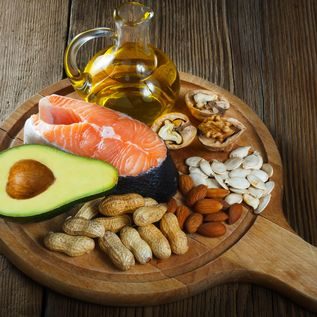
Top 8 Essential Healthy Fats List for Optimal Health
In this blog, we explore the top 8 essential healthy fats necessary for optimal health. Many people opt for fat-free diets in an attempt to lose weight, influenced by outdated nutritional models like the food pyramid, which has undergone significant changes. Recent scientific insights have underscored the importance of healthy fats, especially for individuals undergoing menopause and andropause. Despite previous misconceptions, these fats are not merely safe but are essential for maintaining health during these critical phases.
So in this blog, we’ll explore the essential role of healthy fats, uncover the health benefits, explain the crucial role of healthy fats in Menopause and Andropause, list the top 8 healthiest healthy fats, and also go into bad fats to watch out for.
What Are Healthy Fats and Why Are They Beneficial?
Healthy fats include omega-3 and omega-6 fatty acids, as well as mono- and polyunsaturated fats (MUFAs and PUFAs). These are essential nutrients that our bodies cannot produce on their own and must be obtained through our diets.
Far from being dietary enemies, these fats improve memory, enhance hormone function, and facilitate nutrient absorption. They are essential for brain health, cognitive function, and mood stabilization. They support heart health, lower bad cholesterol and improve insulin levels and blood sugar control which can help with diabetes management and prevention. Moreover, healthy fats are essential for maintaining cell membrane integrity, promoting cell growth, and assisting in the absorption of fat-soluble vitamins A, D, E, and K. They also help maintain hormonal balance and reduce inflammation in the body. Including these fats in your meals makes you feel full after eating, slows the digestion of carbohydrates, and even enhances the flavor of your food.
The Top 8 Essential Healthy Fats List
1.Fatty Fish
Unsaturated and omega-3 fatty acids, which are abundant in fatty fish, are crucial for the heart and brain’s functioning. The American Heart Association advises people to consume two portions of fatty fish per week. Fish prepared to a serving size of about 3 oz.
Options consist of:
- Tuna
- Herring
- Mackerel
- Salmon
- Sardines
- Trout
2.Chia Seeds
Depending on your immune type chia seeds can be a great nutritious source of omega-3 fatty acids and other important nutrients. Including chia seeds in a balanced diet may help lower blood triglycerides, relieve symptoms of rheumatoid arthritis, and potentially reduce blood pressure levels in individuals with type 2 diabetes and hypertension. Chia seeds are also rich in calcium, iron, fiber, protein, and antioxidants.
3.Dark Chocolate
Dark chocolate can be a healthy choice depending on your immune type, offering benefits like heart and brain health due to its flavonoid antioxidants. While it’s a beneficial fat, moderation is essential due to its saturated fat and sugar content. Making your own chocolate with healthier alternatives like agave syrup and coconut oil is an easy and healthier option. However, if you are suffering from mold toxicity, it’s best to avoid chocolate as cocoa beans can harbor mold, potentially worsening your condition.
4.Avocados
Avocados are excellent superfoods, especially beneficial during menopause as they help regulate estrogen levels. Rich in oleic acid, a monounsaturated fatty acid, avocados offer numerous health benefits, including anti-inflammatory properties that may help prevent cancer. They are also a good source of fiber, potassium, and lutein, which supports eye health.
5.Raw Olive Oil
Olive oil is rich in monounsaturated fats, which are great for heart health, and contains powerful antioxidants, vitamin E, and vitamin K. Studies show that substituting olive oil for traditional fats like margarine, butter, and mayonnaise can lower the risk of heart disease. However, it’s important to use olive oil raw, as heating it can produce harmful byproducts linked to cancer risks. Always consume olive oil uncooked to avoid these risks.
6.Coconut Oil/MCT Oil
Coconut oil contains medium-chain triglycerides (MCTs), which can enhance your health when used in small doses. However, it is not advised for those with an immune response like TH1, or conditions such as leaky gut, bacterial overgrowth, or a suspected parasite infection. Additionally, if you have issues with lipopolysaccharides (LPS) — bacterial toxins typically contained within the gut — coconut oil may not be suitable. LPS can cause significant health issues like inflammation if they leak into the bloodstream. If you’re experiencing digestive troubles or suspect pathogenic issues, coconut oil might exacerbate these problems. It’s crucial to thoroughly understand your body’s current state before incorporating coconut oil into your diet.
7.Pumpkin Seeds
Healthy fats, magnesium, and other nutrients can be found in pumpkin seeds. Additionally, they contain a lot of polyunsaturated fatty acids and anti-oxidants like beta-carotene and selenium. They also contain a significant amount of iron.
Pumpkin seeds contain a substance called cucurbitacin that aids in the elimination of roundworms and tapeworms, making them ideal for consumption during full moons or if you suspect parasite activity in your body. However, if you think you may have a parasite, you should always get tested in order to be sure. Nevertheless, eating raw pumpkin seeds can assist in the removal of parasites.
8. Grass Fed Organic Butter
Unhealthy Fats To Watch Out For
The unhealthiest of fats are trans fats and saturated fats. Artificial trans fats are unhealthy and are frequently identified on food labels as partially hydrogenated oils. They cause inflammation, which raises the risk of heart disease, stroke, diabetes, and other illnesses.
A 23% increase in cardiovascular risk is linked to even a 2% daily increase in trans fat calories.
Trans fats can be found in the following foods:
- Fried food
- Frozen dishes like pies and pizzas
- Baked goodies
- Certain kinds of margarine
- Highly processed snacks
Conclusion
Along with carbs and protein, fat is one of the three essential macronutrients the body requires. Healthy monounsaturated and polyunsaturated fats are a part of a balanced diet.
Want more free personalized health tips? Looking to adopt a healthier diet, enhance your mental and physical health, boost your energy, or manage symptoms of menopause, andropause or parasites? For an in-depth discussion on any of the topics covered in this blog, take the Root Cause Analysis (RCA). Get started on your journey to better health today!
We hope the knowledge in the Top 8 Essential Healthy Fats List for Optimal Health blog was interesting to you. Leave your remarks in the section below to let us know what you thought and share with relatives and friends who might benefit from reading this also!



